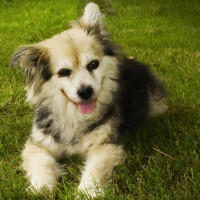Appearance of the Shelestie
|
| A Shelestie is a medium-sized dog with a thick, double-layered, coarse coat that can be water repellent. The most common colors are black, brown, tan and cream, and they can have white markings. They can also be brindle or speckled. They generally weigh between 4.5 and 9 kilos and reach a height of up to 33 centimetres. More closely related to the Shetland Sheepdog, the Shelestie can resemble a miniature Collie, with a long, wedge-shaped head and narrow muzzle. Shelesties have dark, almond-shaped eyes and a black nose. They have a robust, fairly muscular body. |
Temperament of the Shelestie
|
| The Shelestie is an intelligent, affectionate dog that likes to be close to its family. It's a sensitive dog that doesn't like to be alone and can be quite wary of strangers. He'll bark to warn you of an approaching stranger, which makes him a very good watchdog. They are also very protective, but you have to teach them to stop barking, otherwise it can become a problem. But they are very friendly and playful with their family and get on well with children. Because of their intelligence, they are easy to train and respond very well to commands. They are ideal for new dog owners. Early training and socialization is always a good idea to ensure that they are confident with new people and other dogs. Positive reinforcement and lots of praise will give the best training results. These are energetic dogs who will never turn down the opportunity to go out. |
Needs and activities of the Shelestie
|
| The Shelestie is an energetic dog that loves to play. He needs regular daily exercise to expend his energy and stay fit and healthy. They love long walks and playing ball with children. They also love activities like flyball and Frisbee. Make sure your dog is on a leash when out in public, as his hunting ancestors are prone to galloping after small creatures. These dogs are not ideal for apartment-dwellers as they need to run around, but they may adapt if taken out regularly and given indoor play sessions. They're not overly sensitive to heat or cold, but it's never a good idea to exercise them in the middle of the day. |
Maintenance of the Shelestie
|
| The Shelestie tends to shed quite a lot, and requires a fair amount of grooming. Regular brushing will keep its coat looking beautiful and eliminate shedding. Both parent breeds have a double coat, as does the Shelestie. The hard outer coat and softer undercoat protect your dog from the elements and repel water. They don't need regular baths - only when absolutely necessary. Your dog will need trimming from time to time, especially around the feet, ears and eyes. Check ears for dirt and comb out tangles. Teeth should be brushed daily if possible, and nails trimmed if necessary. |









 English (United Kingdom)
English (United Kingdom)